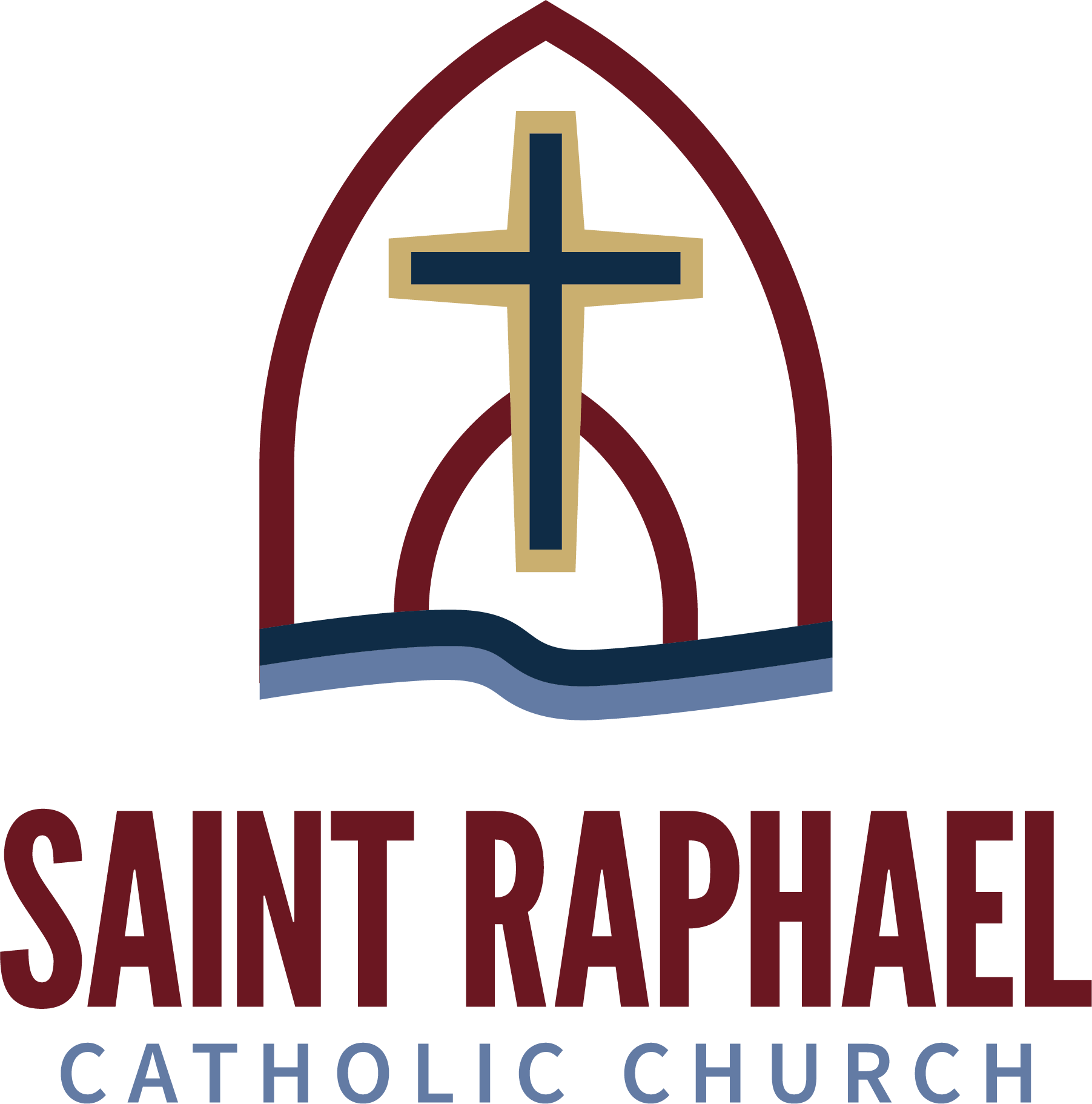MINISTRY DETAILS
Extraordinary Ministers of Holy Communion (emHC)
Overview
An Extraordinary Minister of Holy Communion (emHC) is commissioned by the Bishop to assist the priest when the number of the faithful present is so large that distribution of Communion would be unduly lengthened. The Diocese of Cleveland offers training for new emHCs, usually once or twice a year. The USCCB says that emHCs "should receive sufficient spiritual, theological, and practical formation to fulfill their role with knowledge and reverence." Because they are "extraordinary" (the ordinary ministers of Holy Communion are the priest and deacon), they "should show the greatest reverence for the Most Holy Eucharist by their demeanor, their attire, and the manner in which they handle the consecrated bread or wine." Please see the details further down this page for more information.
Duties
Check-in at the MSP Kiosk in the Priest Sacristy at least 15 minutes prior to the beginning of Mass
Add your name to the white board in the location at which you would like to distribute
Save your seat in a pew and pick up a green hymnal (from the pew you're going to sit in) for yourself
Gather near the sacristy for a prayer with the Presider just prior to the Procession and find yourself a partner to walk with you. Process in with the other ministers, singing the Entrance Hymn. Bow with your partner at the foot of the sanctuary steps and proceed to your pew (where those you came with or your reserved pew card are waiting for you).
Approach the Sanctuary steps at the Lamb of God and stop at the base of the steps in your specified location. You may sanitize your hands. We are no longer asking you to move pedestals.
Ascend the steps when the Priest and Deacon are receiving the Precious Blood.
If you are the minister of the Precious Blood, offer to those ministers next to you who are distributing hosts after you have received.
Begin distribution once all ministers in your section have received their vessels. If your line ends, seek other lines to assist.
When your vessel is empty or all have been fed, return your vessel to the appropriate tray on the Altar and return to your seat, turning to bow as you leave the Sanctuary. If the Deacon is at the Altar, he will provide guidance on any help he may need from you, including sending you to another station to distribute.
Distribution details
The Body of Christ: The proper and only permissible form for distributing Holy Communion is to offer the consecrated bread by saying, "The Body of Christ". No other words or names should be added; and the formula should not be edited in any way. (Cf. GIRM, 161; 284-287).
If the Eucharistic bread or some particle of it falls, it should be picked up reverently by the minister. The consecrated bread may be consumed or completely dissolved in water before being poured down the sacrarium.
The Precious Blood: The proper and only permissible form for distributing Holy Communion is to offer the consecrated wine by saying, "The Blood of Christ". No other words or names should be added; and the formula should not be edited in any way. (Cf. GIRM, 161; 284-287).
Should there be any mishap, for example, if the consecrated wine is spilled from the chalice, the area should be washed and the water poured into the sacrarium.
In those instances when there remains more consecrated wine than was necessary, if needs dictate, Extraordinary Ministers of Holy Communion may consume what remains of the Precious Blood when requested by the Deacon or Priest. In such an instance, take your cup to the Deacon (or Priest) at the Altar. If he needs assistance consuming the Precious Blood (COVID-19: and you are willing to help consume), he will offer you the cup by saying "the Blood of Christ". After saying "Amen", you may reverently consume what remains. The sacred vessels are to be purified by the priest, the deacon or an instituted acolyte. The amount of wine to be consecrated should be carefully measured before the celebration so that none remains afterward. It is strictly forbidden to pour the Precious Blood into the ground or into the sacrarium. (NDRHC, 51-55).
Lectors
Overview
The Ministry of Lector involves proclaiming the readings from Sacred Scripture (with the exception of the Responsorial Psalm, which is normally chanted, and the Gospel, which is proclaimed by the Deacon). In the absence of a psalmist or cantor, the Lector may proclaim the Responsorial Psalm. In the absence of a Deacon, the Lector may announce the intentions of the Universal Prayer (intercessions).
The function and ministry of Lector is distinct: the Lector has a function which only the Lector can carry out.
Duties
Your preparation of the Word is as critical as the priest's or choirmaster's. We encourage you to read the readings for the upcoming Sunday early in the week, to pray with them, and to prepare your proclamation throughout the week.
When you arrive, sign in at the kiosk at least 15 minutes before Mass.
If there is a Deacon, it is his role to carry in the Book of Gospels. If there is no Deacon, a Lector carries the Book of Gospels in the Entrance Procession. Check with the celebrant to see where in the Procession he would like you to be. Carry the Book slightly elevated. Because you are carrying something, you do not bow or stop at the sanctuary steps, but continue into the sancutary, around the altar, and you place the Book of Gospels flat on the center of the Altar.
If there is a Deacon, both lectors process just in front of him. They bow together at the foot of the sanctuary steps, and proceed into the sanctuary to their chairs behind the Ambo.
The First Lector approaches the Ambo when the faithful are seated at the conclusion of the Entrance Rites and proclaims the First Reading (from the Old Testament except during Easter, when the reading is from Acts of the Apostles).
Announce "A reading from...". Please do not say "The First Reading is a Reading from...". Proclaim the Word. Pause at the conclusion of the text before saying "The Word of the Lord."
"The Word of the Lord"... "Thanks be to God" is a dialogue of the Mass. the Lector's part is "The Word of the Lord", and the fiathful's response is "Thanks be to God". Please do not respond to yourself! (allow the faithful to respond to you by listening to them say "Thanks be to God"). (This also applies to the Universal Prayer - the petitions - say "We pray to the Lord" and do not say "Lord, hear our prayer", as that part of the dialogue belongs to the faithful who are responding to you.
The Responsorial Psalm is then sung. If there is no psalmist or cantor, the Lector proclaims the Psalm, bearing in mind that it is a musical text even if it is not being sung. Allow that to inform your proclamation.
The Second Lector proclaims the Second Reading at the conclusion of the Responsorial Psalm, following the same directives as for the First Reading.
At the conclusion of the reading, the Lectors go together to their seats (in the pews reserved for Lectors and family). When we built the new church, the Office of Worship from the Diocese of Cleveland came out to talk about how liturgy should be celebrated in the new space. It was made quite clear that bowing to the altar is done when ministers pass in front of or behind the altar. Therefore, no bow is required when the Lectors leave the sanctuary on the side to return to their pews for the remainder of Mass. Please use your charitable judgment if your partner turns to bow.
If there is no Deacon, the Second Lector announces the Universal Prayer (petitions). Towards the end of the Creed, please go the Ambo, make sure the binder with the petitions is open, and wait for the celebrant to begin the Universal Prayer. At the conclusion of the final petition, please turn towards the Priest to listen to the concluding prayer, and then return to your pew as before.
The Lectors do not process out at the end of Mass.
Volunteer Mass Coordinator (VMC)
Overview
A Volunteer Mass Coordinator (VMC) aids in the pre-Mass coordination of Liturgical Ministers as well as attends the priest at the altar during Communion when a Deacon is not present.
Before Mass duties
Printable aidPhase One - Before Mass
Assist ministers (lectors, emHCs, sacristans, altar servers) with sign in if they need help. This is mostly so we can greet each other as we arrive to minister and celebrate together. Get to know the ministers at your Mass by greeting them and being present if they need assistance.
Assist emHCs with signing in on the board. They may not need any assistance; as above, your presence means assistance is available if they require it.
Before the bells ring (they begin ringing five minutes before Mass), if there are empty emHC slots or a missing lector, see if you can find ministers in the pews. Invite them to minister.
When the bells stop ringing (which happens two minutes before Mass begins), if emHCs are needed, be standing with the appropriate yellow sign just outside the sacristy (in the church), and make sure you get the attention of the person making the announcements. They will begin announcements as the bells stop ringing, and will be looking for the sign.
Assist last minute sign-ins with their ministry as needed.
During Mass duties
Printable aidPhase Two- During Mass (ONLY if NO DEACON is present)
When emHCs approach the steps during the Agnus Dei, the VMC will go up and stand next to the altar servers nearest to the ambo.
When the priest picks up the chalice, and emHCs are coming to the top step, the VMC approaches the priest, who will give you the Body and Blood of Christ.
The Priest will then distribute the Body of Christ to ministers beginning on the Holy Family side.
The VMC goes behind the priest with two Communion cups and purificators, distributing the Precious Blood to two of the four ministers. Return to the altar, get two more cups and purificators, and distribute to the middle group. Return to the altar, get to more cups and purificators, and distribute to the Sacred Heart side group.
If you are ministering in one of the groups, take only one cup and purificator to that group, and then join the group with your cup and purificator when you have distributed the other cups. (This point is the one that is most likely to need some “ironing out” as we experience how things work. As with everything here, we may need to amend these procedures – thanks for being patient as we all learn together!)
When you are finished in your section, return to the altar unless it is obvious your help is needed in another section. From the altar you might: 1. Guide other ministers who are finished with their section to other areas. 2. Assist with the return of the vessels. 3. Ask cup ministers returning with Precious Blood remaining to help consume. Take their cup and present it back to them, saying “The Blood of Christ”. They may also present the cup to you for help in consuming, saying again “The Blood of Christ”.
Sacristan
Overview
A Sacristan prepares the Credence and Offertory tables prior to Mass and cleans the vessels when Mass has ended.
Reminders
1. Ideally, if a priest or deacon is available – they should be the person that is checking the tabernacle to assess for the number of consecrated hosts. This is often not possible/practical. If you as the sacristan need to enter the tabernacle to assess for the number of consecrated hosts, please do so in a most reverent manner.
2. PLEASE use the plastic dish tub to wash the vessels
3. One vessel at a time in the dish tub
4. PLEASE utilize the glass beaker for wine measurement. If the standard amount of wine changes – as decided by the liturgical staff, the line on the beaker will be adjusted by Bill Toler. (DISCUSSION - does the current beaker line need adjusted).
5. After Sunday noon Mass – empty and wash the wine cruet and let dry – to be filled by Monday morning sacristan
6. PLEASE rinse and spot clean purificators with Fels Naptha soap
7. DO NOT immerse the priest chalice in water
8. Remember – the corporal is folded “inside out”
9. Currently at all Masses we are not utilizing the 2 extra gold ciboria.
• Weekend set-up for Saturday 4:30 pm and Sunday 10:00 am Masses may change to add 2 gold ciboria at busier liturgical seasons (Advent, Christmas, Lent and Easter)
• If the gold ciboria are to be added – a note will be posted on the cupboard door near the set-up picture.
10. Run water into the regular sink side, as opposed to the sacrarium side
11. Please do not leave the water running in either sink and walk away.
12. Purification Procedure – if not done by the priest or deacon
• If you as a sacristan are unwilling to consume the small amount of water from purification, please try to find someone who will. (If present, Bill Toler is always happy to consume after purification.) As a last resort, the contents may be placed into the sacrarium drain.
• Purification of the vessels should ideally be done that the credence table. Purification may be done in the sacristy. If the purification is done in the sacristy, it needs to be done entirely separate from washing.
• When purifying the vessels, there is no mandatory prayer for the sacristan to recite, but there is nothing preventing the layperson from saying the prayer that the priest is supposed to say as he purifies the vessels.
13. DISCUSSION - Because of the limited number of EM’s available at the 12:00 noon Mass, the number of vessels used in the set-up may vary from the norm. A great deal of flexibility is appreciated from the 12:00 noon Mass sacristan.
14. Once Mass as started – PLEASE do not run back and forth into the sacristy from the pews unless it is absolutely necessary. We are supposed to be attending Mass and not be a distraction.
15. DISCUSSION – standard for setting up for the following Mass – (Weekends/weekdays).
16. A reference sacristan binder with descriptions and pictures will be forthcoming.
17. See Bill Toler for any liturgical questions/clarifications.
18. See Nancy Keis (lead sacristan) for any sacristy issues/problems or supply needs
Set-up
Wash your hands
Refer to the calendar on the bulletin board in the working sacristy to determine the priest who is assigned to preside at the Mass you are setting up for.
Obtain the key to the locked safe that holds the priest’s chalice from the small basket in the back of the first top drawer nearest to the safe.
• Unlock the safe
• Remove the appropriate chalice
• Remove the tabernacle key from the first hook in the key box
• Close the safe door
• Make sure that the chalice is properly dressed with the ciborium, purificator, pall and corporal (See next page for details.)
• For the weekend Masses and an all school Mass – remove the priest ciborium from on top of the chalice and place a sleeve (100) of small hosts in the priest’s ciborium. Place a large host (5 ¾” host divides into 24 pieces) on top.
• The priest’s ciborium is one of the gifts to place on the offertory table (located at the back of the church at the right center aisle).
• If the offertory table will not be used (many weekday masses and where students are not present), the priest’s chalice is placed on the credence table with the filled ciborium on top of the purificator, the pall on top of the ciborium and the corporal on top of the pall. (Depending upon how many consecrated hosts are reserved in the tabernacle – there could only be the large priest’s host in the priest’s ciborium.)
Place the tabernacle key into the tabernacle. Reverently check the count of consecrated hosts that are reserved in the large ciborium in the tabernacle. (Full = 600; ¾ full = 450; ½ full = 300; ¼ full = 150). Leave the tabernacle key in the tabernacle for the celebration of Mass.
St. Raphael church keeps a reserve of approximately 200 consecrated hosts in the ciborium in the tabernacle.
For weekend Masses, place the priest’s chalice with purificator, pall and corporal in place onto the left side of the credence table. For weekday Masses, when no gifts are to be brought from the offertory table, place the priest’s fully dressed chalice with purificator, ciborium, pall and corporal (placed onto the chalice in that order) onto the left side of the credence table.
Assure that the priest’s chalice is dressed properly. Some of the chalices have a “front”. For example, there is a cross at the front base of the chalice St. Raphael uses for a visiting priest.
• Place the front of the chalice facing you.
• Open the purificator from being folded in half and lay it over the right and left side of the chalice.
• Place the prepared ciborium over the purificator and on top of the chalice
• Place the pall on top of the ciborium
o Some of the palls are directional – please make sure that the pall is place on top of the ciborium in the correct direction
• Place the corporal (folded crisply inside out) on top of the pall
Remove the wine cruet from the refrigerator. If the wine cruet has been washed (as it is after the Sunday 12 noon mass), fill the wine cruet. The wine level for the cruet should be just below the neck of the cruet.
For weekend Masses and weekday Masses when students are in attendance place the wine cruet on the offertory table (located at the back of the church at the right center aisle).
Fill the water cruet with room temperature tap water to just below the neck of the cruet. Place the water cruet next to the lavabo bowl (handwashing bowl) on the credence table.
Make sure that a clean, dry lavabo towel (white terry towel with red cross) is on top of the lavabo bowl.
Make sure that there is a small (2 inch) gold ciborium for gluten free hosts in the right upper corner of the credence table. Make sure that there are several gluten free hosts in the bag on the credence table. (Additional gluten free hosts are located in the door of the refrigerator in a cardboard box.)
A large metal rectangular tray is used for weekend Masses and all school Masses for carrying the ciboria to the altar. It is set up differently for the various weekend Masses, depending upon how many Extraordinary ministers of Holy Communion will be distributing Holy communion in addition to the priest and deacon. (Pictures of set up of the tray and credence table for each of the various Masses are posted on the cupboard door in the working sacristy.) Once the tray is prepared, place the tray on the credence table.
A round metal tray with a specified number of cups and purificators is used for weekend and daily Masses. Use the marked glass beaker to fill the cups with the designated measurement of wine.
All weekend Masses & All school Masses
o The large rectangular tray will hold 5 silver ciboria and 1 (3 inch) ciborium (used by the designated usher to distribute the Eucharist to the handicapped).
o The round tray with 6 cups and 6 purificators. Using the marked glass beaker, fill the cups with the designated measurement of wine
4:30 pm Saturday Mass and 10:00 am Sunday Mass during designated seasons/times (ie. Advent, Christmas, Lent and Easter)
o The large rectangular tray will hold 5 silver ciboria, 2 gold ciboria and 1 (3inch) ciborium (used by the designated usher to distribute the Eucharist to the handicapped.
o The round tray with 6 cups and 6 purificators. Using the marked glass beaker, fill the cups with the designated measurement of wine.
Daily Mass – No St. Raphael school students in attendance
o The following items are placed on the credence table:
The priest’s fully dressed chalice with ciborium, purificator, pall and corporal
A small round tray with two communion cups, two purificators and one ciborium
Daily Mass with ONE grade level (Grades 3-8) – St. Raphael School
o Two extra ciboria with 50 hosts in each are placed on a round metal tray
o The third ciborium (for the deacon or Extraordinary Minister of Holy Communion) is also placed on the tray with the predetermined number of hosts
o Students will be assigned to carry up the gifts of bread and wine
o No wine is used for daily Mass when one or two classes of students are present.
Daily Mass with TWO grade levels (Grades 3-8) – St. Raphael School
o Two extra ciboria with 100 host in each are placed on a round metal tray
o The third ciborium (for the deacon or Extraordinary Minister of Holy Communion) is also placed on the tray with the predetermined number of hosts
o Students will be assigned to carry up the gifts of bread and wine
o No wine is used for daily Mass when one or two classes of students are present.
Daily Mass with Grades K – 2 – St. Raphael School
o No extra ciboria or hosts are needed
o Students will be assigned to carry up the gifts of bread and wine
o Set up is the same for a regular daily Mass – A round tray with 1 ciborium and 2 cups and 2 purificators
The following factors are considered when determining how many hosts to put out in the ciboria.
o The average/expected attendance at the particular Mass.
o The number of consecrated hosts reserved in the tabernacle. (Generally, after a Mass is celebrated, it is desired to have approximately 200 consecrated hosts reserved in the tabernacle.)
Depending upon the particular Mass…
• If the number of consecrated hosts reserved in the tabernacle is significantly greater than 200, it is possible that no additional hosts will be placed in the ciboria for consecration.
• If the number of consecrated hosts reserved in the tabernacle is significantly greater than 200, it is possible that the priest’s ciborium will be prepared with only the large (5 ¾”) host
For Masses where the gifts will be brought to the altar – place the wine cruet and the priest’s prepared ciborium on the offertory table (located at the back of the church at the right center aisle).
The sacristan should stay in the sacristy until the Mass begins. Please do a final check of the credence table before you sit down. If low gluten hosts have been placed in the small (2 inch) ciborium, please make sure it is placed on the tray (when used) with the other ciboria or placed next to the chalice and ciborium when a tray is not used (daily Mass) for the server to take to the altar.
Clean-up
Generally, at all Masses, the priest or deacon or both will purify the vessels used during the Mass at the credence table. Some visiting priests do not purify the vessels. There may be an occasion when a regular St. Raphael priest or deacon does not purify the vessels. If the vessels have not been purified at the credence table, please purify them, in the manner that the priest or deacon would have purified them. This may be done at the credence table, or in the working sacristy prior to washing the vessels.
AFTER the vessels are purified, all vessels used at the altar during the Mass will need to be first rinsed in the sacrarium. This will ensure that any fragments of the consecrated host that may have been inadvertently left in a vessel after purification are properly attended to. The sacrarium is the sink with a drain that flows directly into the earth.
The vessels should be first rinsed in the sacrarium prior to being washed even if they have been purified at the credence table by the priest or deacon.
Fill the plastic dish pan with warm soapy water in the left sink.
PLEASE use the plastic dish pan to avoid scratching/denting the vessels
Open the metal lid of the sacrarium.
Carefully open the corporal over the sacrarium and lightly shake-out to assure any crumbs of the consecrated host fall into the sink. If the corporal remains clean and with crisp fold lines, refold it (wrong-side out) for re-use.
• If the corporal is soiled, rinse it in the sacrarium and replace with a clean one in the drawer marked “corporals”.
Rinse the purificator(s) in the sacrarium. If there are any stains (wine or lipstick, please use Fels Naptha soap to remove the stain. (After being rinsed, the purificator may then be used to wash the vessels.)
Carefully wash the priest’s chalice with soapy water. DO NOT IMMERSE the chalice into the water. Avoid getting water into any opening in the decorative filigree. Use a purificator to wash the chalice, being careful not to leave scratch marks inside or outside of the chalice from your rings.
Wash one vessel at a time. To avoid scratching/denting the vessels – please do not put multiple vessels in the dish tub at the same time.
Wash the ciboria, cup(s) if used and the water cruet and stopper.
Empty the water cruet and wash the cruet and stopper.
Wash, rinse and dry the outside of the wine cruet and replace into the refrigerator.
After the Sunday Noon Mass only, pour the wine from the cruet back into the wine bottle and wash the wine cruet and stopper.
When rinsing items after washing, use the left sink as opposed to the sacrarium sink.
Dry the chalice and ciboria.
Let the cruet(s) and stopper(s) air dry until filled for the next Mass.
Re-dress the chalice. Make sure the chalice and ciboria are completely dry prior to re-dressing.
• If there is a front to the chalice – this will face you as you re-dress the chalice.
• Open and hang a clean purificator over the top and sides of the chalice.
• Place a ciborium over the purificator.
• Place a pall on top of the ciborium. (If the pall has a directional design, please make sure it is facing the correct direction – (ie. the IHS on the pall is right side up).
Place the re-dressed chalice into the locked safe.
Make sure that the tabernacle key is out of the tabernacle and locked in the safe.
• The tabernacle key belongs on the first hook of the key box inside the safe.
• Do not lock or close the little key door.
• Lock the safe door and return the key to the basket in the back of the top drawer
For weekend Masses – reset the ciboria tray for the next weekend Mass. Look at estimated attendance, number of consecrated hosts in the tabernacle for an estimate of how many hosts to put out.
For daily Masses and after the Sunday Noon Mass, put everything away.
• Return cups to the cupboard marked “cups”.
• Return the ciboria to the cupboard marked “Ciboria” – stack with coffee filters in between each bowl.
It is important to replace the small (2 inch) gold ciborium for low gluten hosts on the credence table (if used). There should be a low gluten ciborium on the credence table at all times.
Wash and dry the lavabo (handwashing bowl). Put a clean lavabo towel (white towel with red cross) in the bowl and replace on credence table.
Place empty wine bottles in the wine cabinet in the container marked “empty wine bottles”.
Keep 3-4 bottles of wine in the refrigerator
Dump the soapy water down the drain of the left (regular) sink.
Dry both sinks and close the sacrarium lid.
Dry the counter as necessary.
Hang the wet linens – purificator(s), lavabo towel, dish drying towel on the drying rack.
Class Mass 9:15am (1 or 2 classes present)
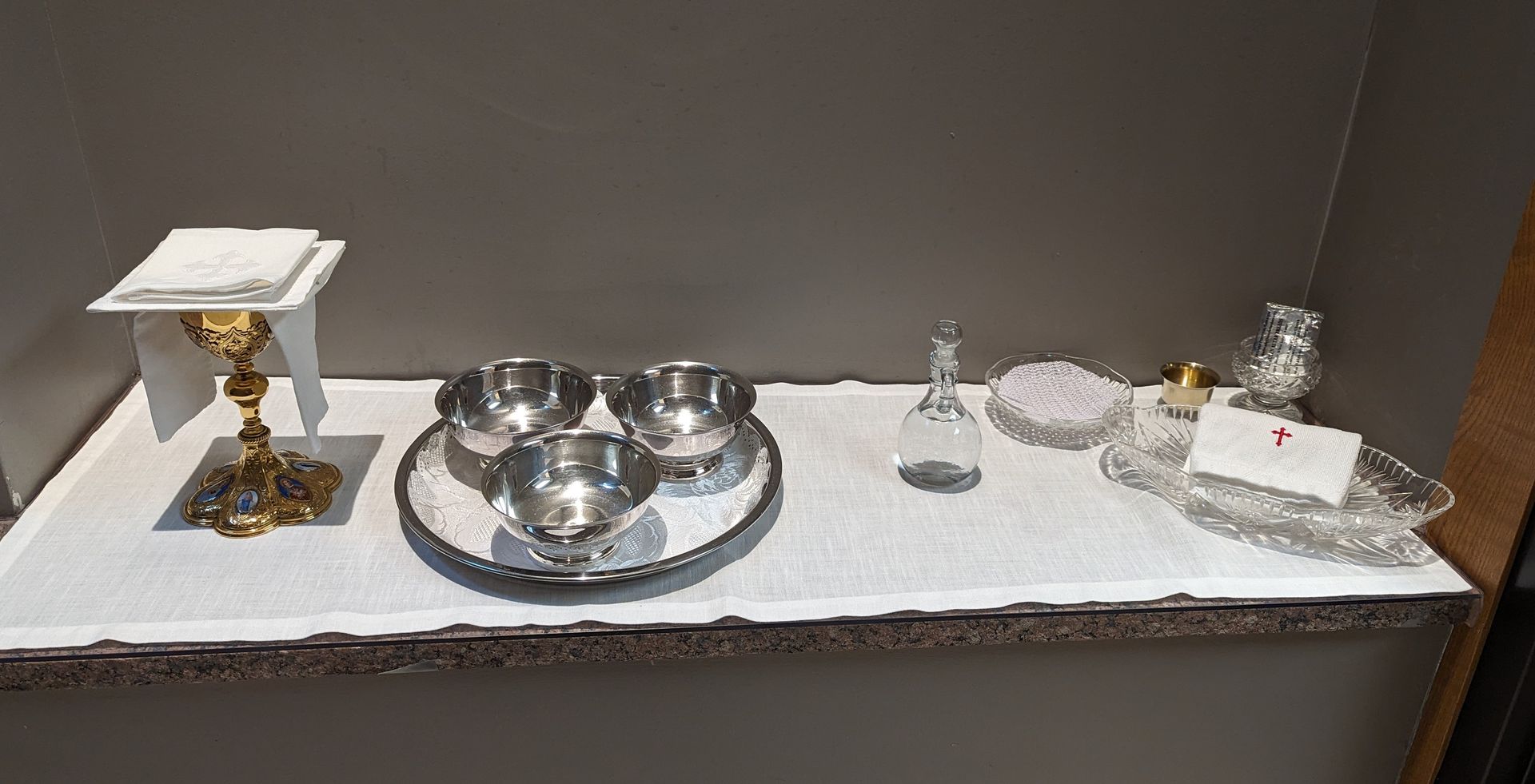
The Precious Blood is not offered at Daily 9:15am Class Masses.
Set Offertory Table with bread and wine as children will bring up the gifts.
Daily 7:45 am & 9:15am Masses
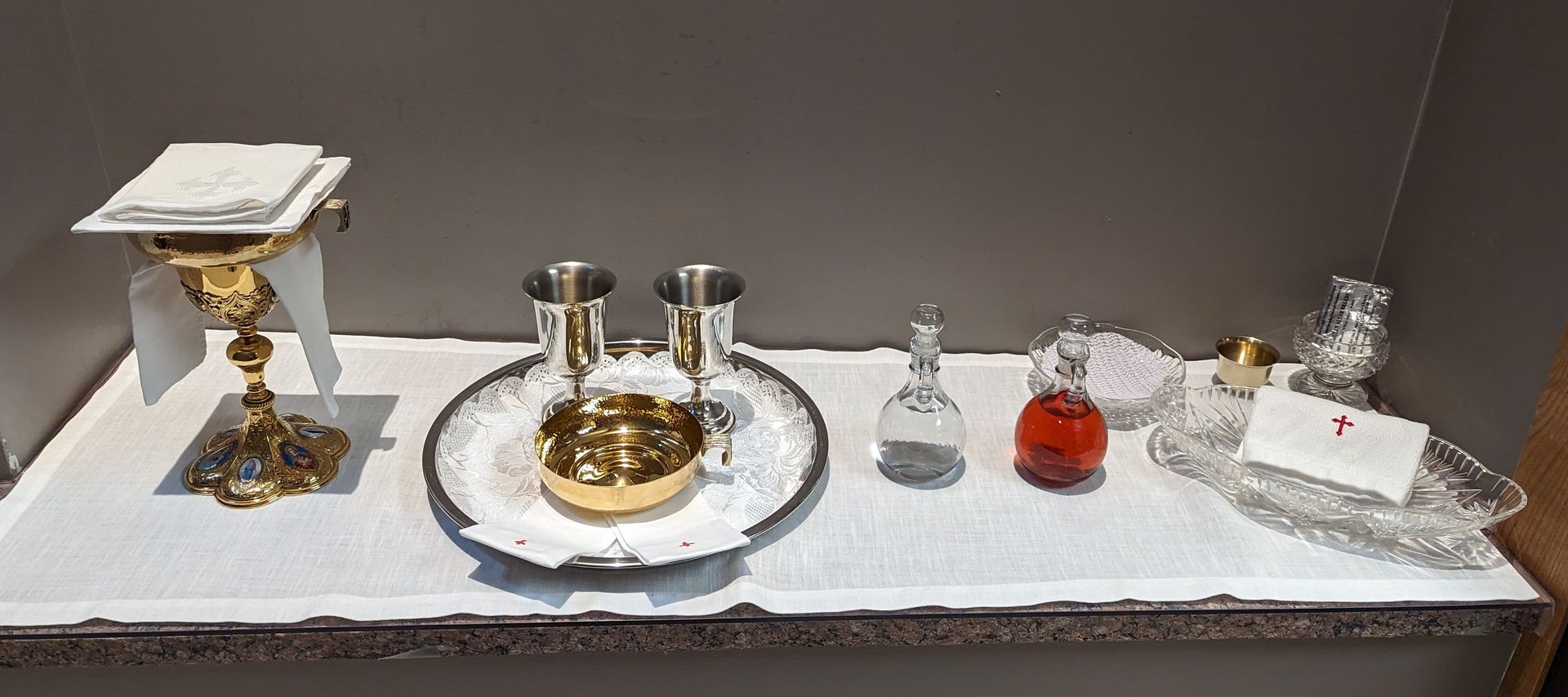
Setup for both 7:45am and 9:15am Daily Mass when no students are present.
Do not set Offertory Table
Saturday 4:30pm & Sunday 10:00am Masses (during Advent, Christmas, Lent, and Easter)
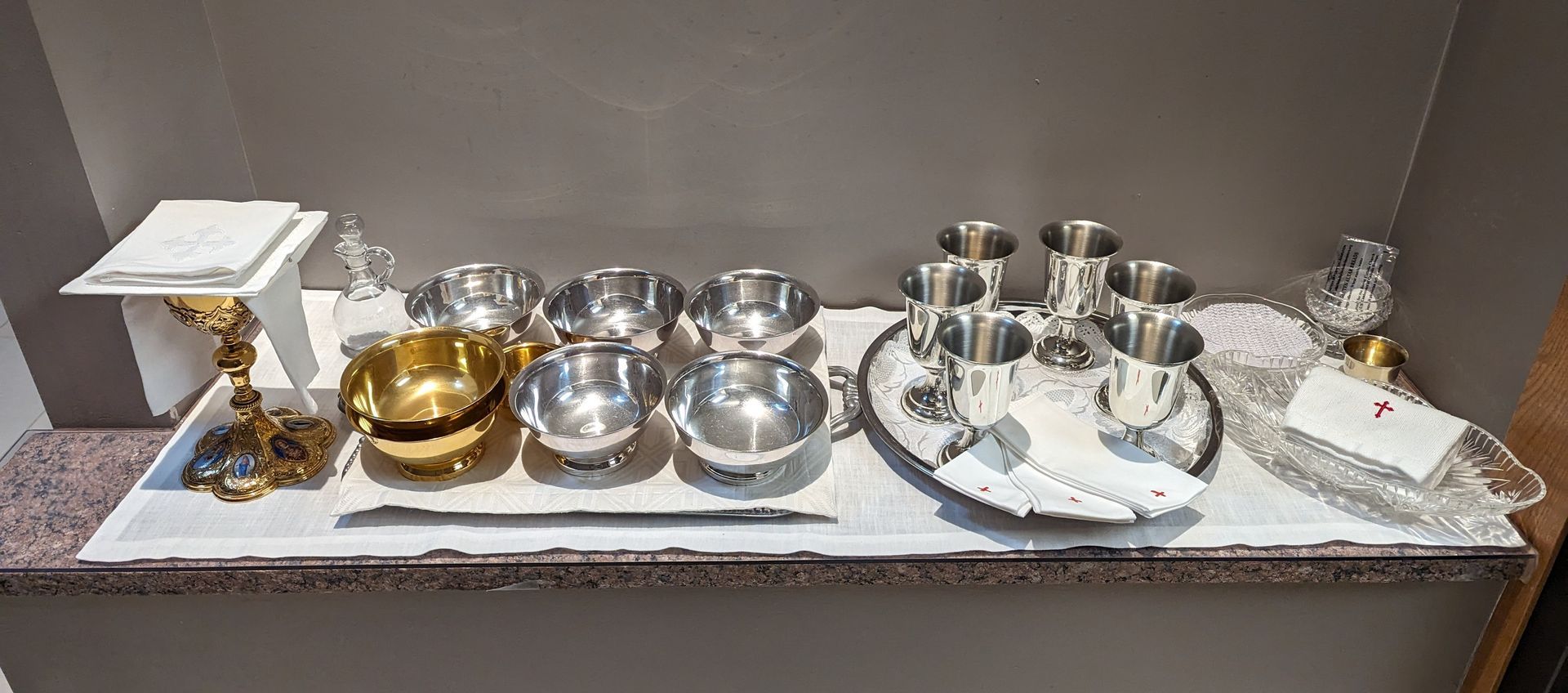
This setup is for 4:30pm and 10:00am Weekend Masses during Advent, Christmas, Lent, and Easter.
Set Offertory Table
Sunday 8:00am & Sunday 12:00pm Masses, All Weekend Masses Ordinary Time
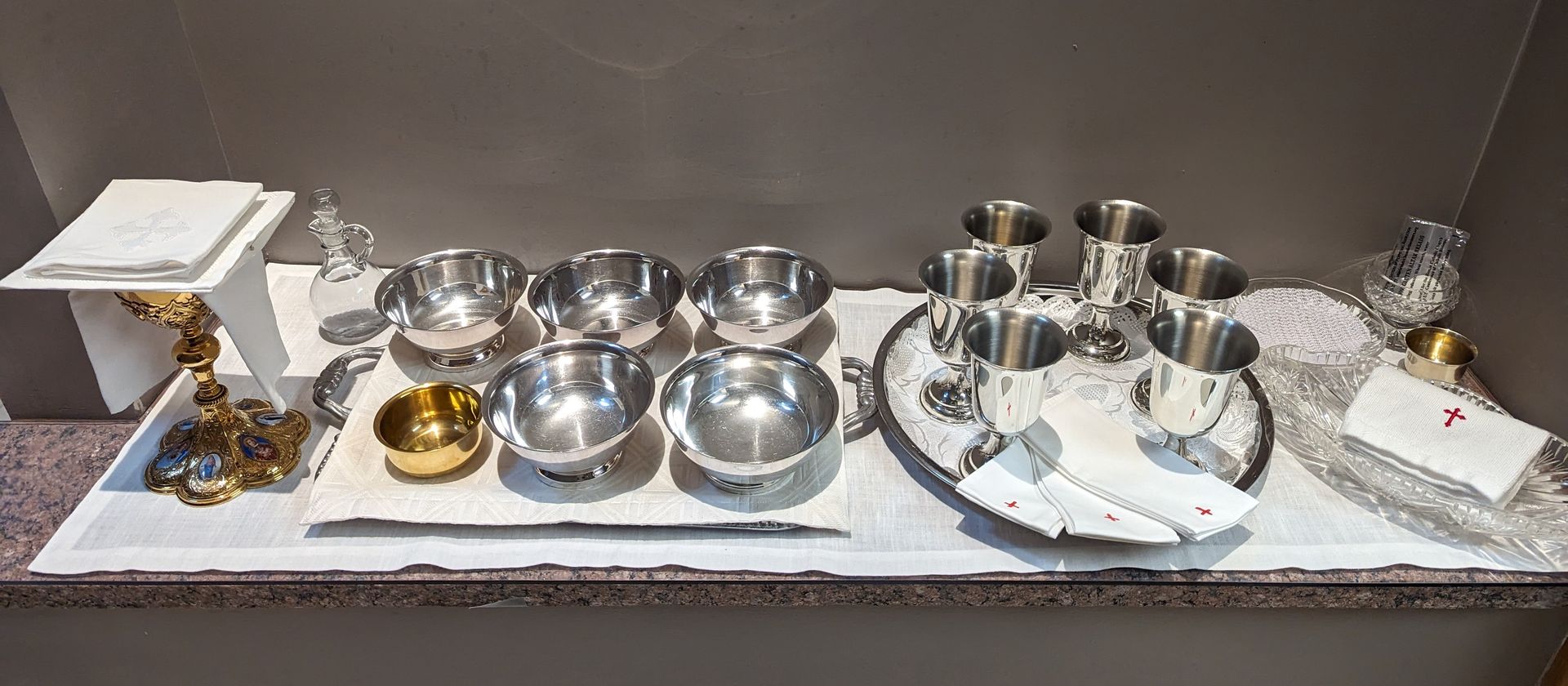
During Ordinary Time this set up is used at all Weekend Masses.
Set Offertory Table.

Office Hours:
9am-8pm (M-Th)
9am-5pm (F)
10am-3:30pm (Sat)
And in the Welcome Center at weekend Mass times
REGULAR MASS TIMES
Saturday Vigil
4:30pm
Sunday Masses
8:00am, 10:00am, 12:00pm
Daily Masses
7:45am (M, T, W, F)
9:15am (M, T, Th, F)
Confession
Saturday 3:00 - 4:00pm & by appointment
Adoration
10:00am Friday - Saturday at 4:00pm

